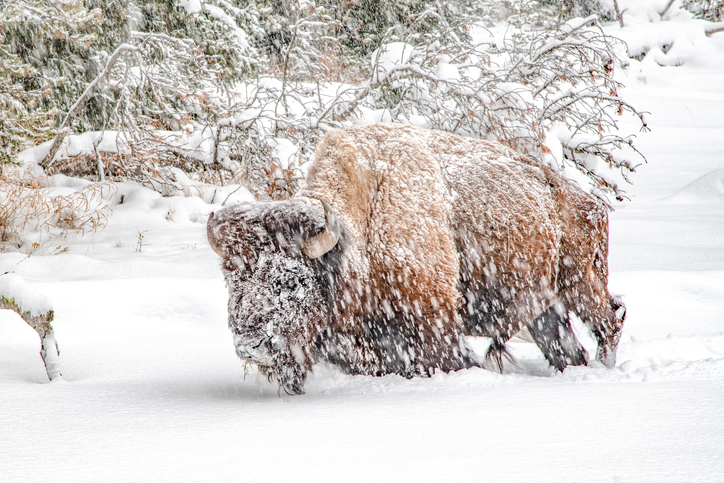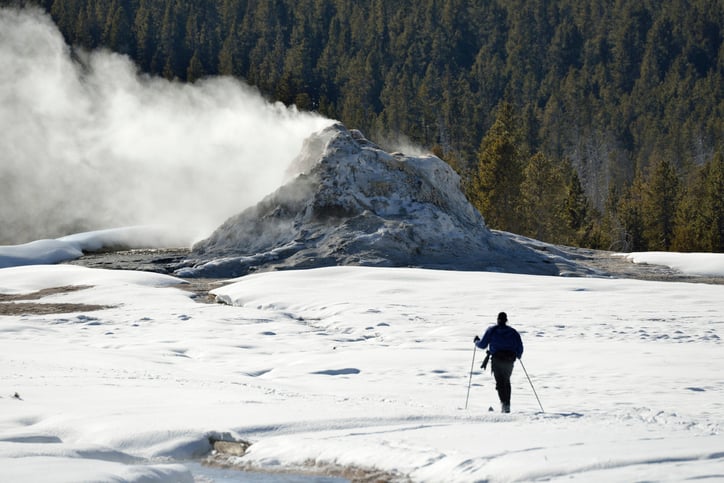Bundle up and dress in layers!
If you’ve had the good fortune to have visited Yellowstone National Park, there’s a pretty good chance you’ve done so between May and September. That’s when the majority of Yellowstone’s nearly 4 million annual visitors explore the first of our national parks.

But if you think you know Yellowstone from your warm-weather visit, you need to return from November through March, among the least busy months for the park. They present some remarkable opportunities when the snow is so deep and the cold so intense that bison develop beards of snow and ice.
“It’s a completely different place in the winter than in the summer, but equally amazing and beautiful,” says Yellowstone spokesperson Sandy Fennell-Dobert.
Just like other parts of the world, the winter weather in Yellowstone can take unexpected turns. But temperatures typically range from zero to 20°F during the day and often drop to sub-zero at night. It doesn’t take a math wizard to factor in the wind chill and know that nighttime in the park can indeed be brutal. Record lows of minus 66°F have occurred.
It gets so cold at times that the near-boiling water from Old Faithful and other geysers freezes in mid-air, falling to the ground as ice pellets. The park rangers call the phenomenon “geyser rain.”
The snow itself is very dry—not at all good for snowball fights—but with an average of 150 inches per year, it creates a dramatic visual blanket that any lover of America’s national parks must see once in their lives.
Here are a few packing tips for not just surviving, but enjoying your time in this frozen national landscape.
Layers
Sure, you’ve heard it before, but layers of fleece and wool are required for winter in Yellowstone. Forget anything cotton because it absorbs moisture from your body and then quickly turns cold. A heavy down coat with hood is also a necessity. Better still, put on a knit hat first, then pull that hood up over it.
Gloves
Protect your hands with heavy-duty gloves. Fleece utility gloves are common for those who work outside in winter. Battery-operated warming gloves are another, albeit somewhat expensive, option. An inexpensive choice for fingers (and toes) is disposable hand warmers that can be slipped into gloves, pockets or boots.
Scarves
Don’t forget a good winter scarf or neck warmer.
Boots
Boots are essential, especially if you plan to do much walking. Layers are just as important here as on other body parts. Make sure your boots, which should be waterproof, are big enough to accommodate multiple layers of socks. Ladies, forget about high-fashion boots with heels. Nothing could be more impractical.
Sunglasses
Sunglasses are a given, but if you plan to be outdoors a lot, consider ski goggles to better protect your eyes from wind and cold. Bring drops to replenish the fluid in your eyes.
Lotions
It may be winter, but you can still get a sunburn. Pack sunscreen along with heavy-duty lip balm and gallons of hand/body lotions to counteract the dry air. In the same vein, remember to drink a lot of water. The dry air and cold temperatures contribute to dehydration.
Restraint
Finally, take it easy. The average elevation in Yellowstone is 8,000 feet above sea level. That, combined with extreme cold and dry air, catches up with you faster than you think.
For more information and reservations, visit yellowstonenationalparklodges.com/lodging/winter-lodges.


